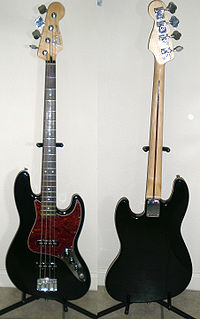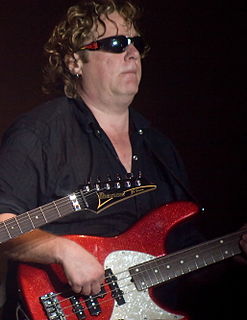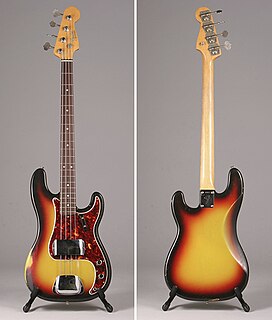The Fender Jazzmaster is an electric guitar designed as a more expensive sibling to the Fender Stratocaster. First introduced at the 1958 NAMM Show, it was initially marketed to jazz guitarists, but found favor among surf rock guitarists in the early 1960s. Its appearance is similar to the Jaguar, though it is tonally and physically different in many technical ways.
The Fender Jaguar is an electric guitar by Fender Musical Instruments characterized by an offset-waist body, a relatively unusual switching system with two separate circuits for lead and rhythm, and a medium-scale 24" neck. Owing some roots to the Jazzmaster, it was introduced in 1962 as Fender's feature-laden top-of-the-line model, designed to lure players from Gibson. During its initial 13-year production run, the Jaguar did not sell as well as the less expensive Stratocaster and Telecaster, and achieved its most noticeable popularity in the surf music scene. After the Jaguar was taken out of production in 1975, vintage Jaguars became popular first with American punk rock players, and then more so during the alternative rock, shoegazing and indie rock movements of the 1980s and 1990s. Fender began making a version in Japan in the mid-1980s, and then introduced a USA-made reissue in 1999. Since then, Fender has made a variety of Jaguars in America, Mexico, and China under both the Fender and Squier labels. Original vintage Jaguars sell for many times their original price.

The Jazz Bass is the second model of electric bass created by Leo Fender. It is distinct from the Precision Bass in that its tone is brighter and richer in the midrange and treble with less emphasis on the fundamental frequency. It has a more focused tone than the Precision Bass, with less low end and low midrange. The sound of the Jazz Bass has been fundamental in the development of signature sounds in certain musical genres, such as funk, disco, reggae, blues, progressive rock, heavy metal and jazz fusion. The body shape is also different from the Precision Bass, in that the Precision Bass has a symmetrical lower bout on the body, designed after the Telecaster and Stratocaster lines of guitars, while the Jazz Bass has an offset lower bout, mimicking the design aesthetic of the Jaguar and Jazzmaster guitars.

The Fender Mustang is a solid body electric guitar produced by the Fender Musical Instruments Corporation. It was introduced in 1964 as the basis of a major redesign of Fender's student models, the Musicmaster and Duo-Sonic. It was produced until 1982 and reissued in 1990.
The Fender Lead Series was produced by the Fender/Rogers/Rhodes Division of CBS Musical Instruments. The series comprised Lead I, Lead II, Lead III and Lead Bass models.
The Fender Mustang Bass is an electric bass guitar model produced by Fender. Two variants, the Musicmaster Bass and the Bronco Bass, have also been produced from time to time using the same body and neck shape.

Vox bass guitar is any of the bass guitars made by Vox, a British musical equipment company, in the 1960s. Vox made a number of bass guitars during the 1960s, although they were not nearly as successful as their efforts in amplifiers.

The Fender Jaguar Bass is an electric bass guitar manufactured in Japan and China by the Fender Musical Instruments Corporation.

The Squier Super-Sonic was a guitar manufactured and sold by Squier for two years in the 1990s as part of Fender's 1997 Vista series. The guitar was designed by Joe Carducci, who was Fender's electric guitar product manager at the time, and who may have been inspired by an image of Jimi Hendrix playing a Fender Jazzmaster 'upside-down', or left-handed.
The Fender Telecaster Bass is an electric bass introduced in 1968 by Fender Musical Instruments Corporation. With few physical changes through the 1970s, it was discontinued in 1979 and reissued in 2007 by Fender's subsidiary Squier as the Squier Vintage Modified Precision Bass TB, which was discontinued in 2014.
The Fender Bullet was an electric guitar originally designed by John Page and manufactured and marketed by the Fender Musical Instruments Corporation. It was first introduced as a line of "student" guitars to replace the outgoing Mustang and Musicmaster models.

The Fender Aerodyne Jazz Bass is an electric bass guitar created by Fender and was first introduced at Winter NAMM 2003.
The Frank Bello Bass is an Artist Series electric bass guitar made by Fender Musical Instruments Corporation for thrash metal band Anthrax's bassist, Frank Bello. Modeled after the Aerodyne J-Bass, this signature model features a slab-cut alder Jazz Bass body, a modern C-shaped maple Precision Bass neck featuring a rosewood fretboard with 20 medium jumbo frets and a matching black headstock with a Fender Bass decal. Electronics consisted by a Seymour Duncan Basslines SPB-3 Quarter Pound split-coil humbucking pickup in the neck position, a Samarium Cobalt Noiseless Jazz Bass single-coil pickup in the bridge and a single volume control knob. Other features include Fender/Schaller Deluxe Lite-Bass straight-shaft tuning machines, a BadAss III strings-through-body/top-load bridge, Bello's caricature on the back of the headstock and his signature on the neck plate. It was introduced in 2005 and followed by a Squier version in 2007, featuring a skull graphic on the body, a skull inlay on the 12th fret, an Angry Man graphic on the back of the headstock, a standard vintage-style bridge, standard open-gear tuners and two single separate volumes without tone controls for the P neck and J bridge pickups.
The Fender Prodigy is a discontinued model of electric guitar produced by Fender from 1991 to 1993. It is one of Fender's attempts to compete with the superstrat-style guitars produced by Ibanez, Jackson/Charvel, Carvin Corporation and Yamaha. Since the Prodigy series was discontinued after about two and half years of production without a clear reason, it is considered one of Fender's rare models because of its limited production. Fender also produced a Prodigy bass based on the Precision Bass Plus Deluxe featuring a P/J pickup layout, 2-band active circuitry and a "fine-tuner" Schaller Elite bridge assembly.
The Fender American Deluxe Series was a line of electric guitars and basses introduced by Fender in 1998 and discontinued in 2016. It was upgraded in 2004 and 2010 before being replaced by the American Elite series in 2016.

Starcaster by Fender is a range of instruments and accessories aimed at students/beginners, marketed by the prominent guitar company Fender from the early 2000s until at least 2011. As of April 2018 no products were being marketed under this brand.

The Fender Urge Bass and Fender Urge II Bass are models of electric bass guitars produced by Fender. The models were designed and are endorsed by bassist Stu Hamm.
The Yamaha Corporation is a multinational corporation and conglomerate based in Japan with a wide range of products and services, predominantly musical instruments, motorcycles, power sports equipment and electronics.
The Fender Telecaster, colloquially known as the Tele, is the world's first commercially successful solid-body electric guitar. Its simple yet effective design and revolutionary sound broke ground and set trends in electric guitar manufacturing and popular music. Introduced for national distribution as the Broadcaster in the autumn of 1950, it was the first guitar of its kind manufactured on a substantial scale and has been in continuous production in one form or another since its first incarnation.












